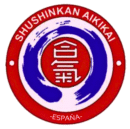THE PRACTICE OF AIKIDO
Introduction
It is practiced in the dojo (practice area), on tatami mats. After warming up, conditioning, and stretching, the practice begins with body movements (aikitaiso).
Aikido is practiced in pairs, who repeatedly perform an attack and defense movement previously demonstrated by the instructor. The attacker (uke) delivers an attack (blow, front or back grab) that the nague receives, and the nague performs a technique to counter the attack. The uke (attacker) performs ukemi (a movement with or without falling onto the mat to protect himself) to safely resolve the application of the nague's technique.
The technique comprises an opening movement, a development and its completion, with the attacker's projection or retention.
The essence of all Aikido techniques is the use of all parts of the body to create a spherical movement around a stable and energized center. Even though a technique appears to use only one part of the body, close observation reveals that the movements of Aikidokas are, in fact, movements of the entire body.
Properly executed, some techniques are spectacular, sending the opponent soaring through the air. Others are small, skillful, and precise movements that immobilize the attacker. Both results are achieved through the precise use of leverage, inertia, gravity, dissociation, body axis, weight shifts, and the action of centrifugal and centripetal forces.
Ultimately, it is the energy of the attack itself that brings the attacker to the ground.
As a result of training, a person increases their physical and mental endurance, flexibility, and muscular development, even though the techniques themselves do not depend on strength for their effectiveness. Since Aikido movements and techniques derive from the most efficient utilization of the entire being, the practitioner can develop great power without requiring much physical strength.
Aikido can be practiced in a variety of ways, but it's not an activity that focuses on the rigidity of training, but rather, on the search for relaxation and freedom. Aikido can be practiced by men, women, and children of all ages.
The aikido practitioner develops a relaxed yet firm and stable posture, in which the body's weight is directed toward its physical center, located in the lower abdomen. Gravity ceases to be a force to be overcome; rather, it serves to support and stabilize the posture. As a result, ordinary movements take on an appearance of grace and economy. The effects of centering are both physical and mental. In addition, vitality increases, the senses are sharpened and honed, and one is less affected by the irritations and vexations of daily life. This state is known in Japan as having Hara, or strong Ki. It is a manifestation of inner quality, which leads the aikido student to develop their full potential in all areas of life.
Additionally, and as a very important part of the practice, the roles of attacker and defender (uke and nage) are changed, and the student also learns how to land safely on the tatami without injury (ukemi), and how to protect themselves when receiving the technique applied by the defender in reaction to the attack. After a short time of practice, the student begins to perform the attack and defense movements more continuously: attacking, receiving the technique, falling to the tatami, immediately getting up and attacking, then receiving the attack, performing the entry, opening, development, and completion of the technique. This develops greater aerobic endurance in the practitioner and awakens the notion of attention and perception of what is happening around them, while simultaneously acquiring self-confidence. Continuous practice and repetition of movements is "zen," being in the moment, living in the moment.
Although there are grades or degrees, in Aikido we are all beginners, and we practice without regard for the grade of our partner, and seniority in practice does not mean neglecting the newer student. On the contrary, new students are welcomed and cared for by the more senior ones. The grading system allows for organizing the practice, determining the seniority of practice, the state of learning, and the individual's evolution, which helps the individual on their path and the newer ones as they begin a new activity. It is not a system of power or subjugation of the lesser graduate, but rather of service to those who know less, of transmission, not imposition.
Each student has different physical abilities and different reasons for practicing Aikido, all of which deserve respect.
True Aiki is the correct and flexible application of appropriate technique in any circumstance. It is our responsibility not to cause any harm. We must protect our partner and ourselves. (Mitsugi Saotome Shihan, Aikido or the Harmony of Nature)
Come to the Dojo to attend a class or practice.
You can start practicing in long pants, a t-shirt, or a sweatshirt.
Contact us
We are at Buhda Gym in Lloret de Mar, Girona
